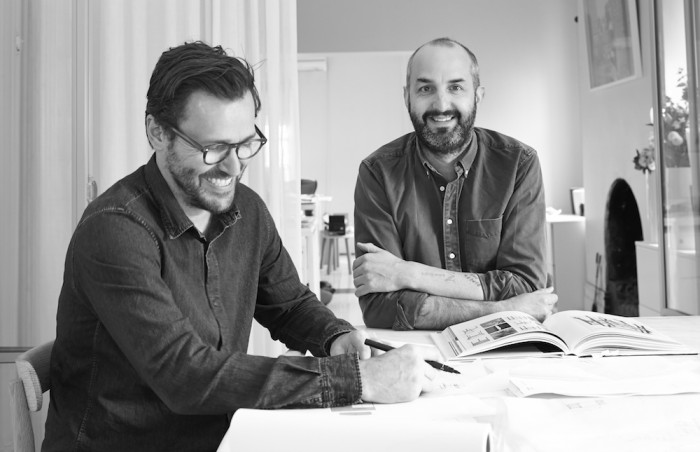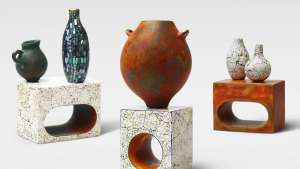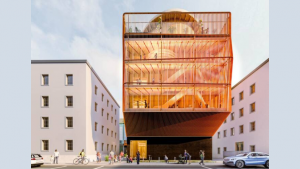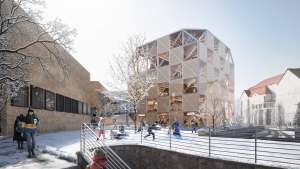
Nick Cox and Dion Hall are the co-founders of Melbourne-based Projects of Imagination (POI), a studio centred in designing spaces for restaurants and the hospitality industry. When it comes to designing a space, they cover every aspect of a business, from interior architecture to branding and strategy, which gives them a multi-disciplinary perspective of design.
As food design and foodie culture continues to expand on a global scale, Cox and Hall are on a mission to “reshape the way people dine” through their high-concept creations. In this interview, they expand on the fundamentals of designing spaces for gastronomic experiences.
How did POI come to be?
Nick: I met Dion Hall in 2000. We worked together (often paired together) in a couple of studios before founding POI in 2007. My background is in graphic design, and Dion’s background is in building, sculpture, and interiors. We wanted to remove all constraints from the traditional way of doing projects and create the freedom to consult on every touch point, tackling every angle of the project – that’s why we started POI.
Melbourne is one of the top culinary capitals of the world. Dion’s background in hospitality and our common connections within the industry meant that sector would be a key focus for us.
We identified a need early on to reshape the way people dine.
There are so many elements that go into a restaurant’s space – where do you begin?
Dion: The first step involves very basic discussions about the brief, timeline and budget. If a potential client can’t respond to segments within this equation, we know we may not have the right partner. We like people who are focussed on quality and value the creative process. So you could say we begin with the selection of the client and not necessarily the project itself.
If the client’s business model is clear and well resolved, the creative process is more seamless and the outcome benefits. If it is not then the creative process often suffers as it consumes the responsibility to solve the business proposition. Once a clear direction is formed, we commence on various pathways: master planning, spatial studies, economic assessments, schematic design, etc.
Nick: I work on the brand experience and Dion’s focus is on the space. We work together upfront to define the high level concept and then our separate teams help shape the narrative, but they’re always talking to each other. We never start the brand development until we have a name – and that is a process (a very political one) within itself.
You create spaces for the hospitality industry. How much of what you do is creative and how much of it is business?
Dion: I would love to say it is more creative than business analysis but the simple reality is it is commercial therefore the realm of commerce is always intertwined. It's a fine balance between both worlds.
In your experience, could a restaurant still be popular if it was a really great space but served average food?
Nick: No. We don’t believe the food tastes better when the space feels great, or the space looks better when the food tastes great.
Restaurants are an immersive experience and every touch point, most importantly the food must be delivered holistically for that business to be a truly successful user end experience and commercially viable entity.
When tasked with a new project, do you take the lead in formulating a concept and style for the restaurant or is that largely driven by the client?
Dion: That's a double-edged question, as most clients would like to claim they have created the master vision. Often when clients do have a concept in mind, we need to ensure its authenticity. In some cases, client briefs often request for outcomes we have already produced or are lifting from someone else's ideas. Naturally we want to create innovative and truthful outcomes. In most cases, the client has a food and beverage brief and we are appointed to lead the creative.
Do you create a soundtrack for the restaurants you design or is that up to the owner?
Nick: We are pretty aware of what sort of music is right for each dining experience, time, day and volume, and will brief either a DJ or a musician to put together potential playlists, which will evolve over time as well. Better to not leave it up to the client and their iPod.
The massive foodie culture that has swept the globe seems to be more about social experience and gastronomic artistry than the food itself. What are your feelings about this, from a social and a business perspective?
Dion: I feel there are two key sides to the food revolution. One significant benefit is the focus and awareness on healthier lifestyles. The level of education and access to more sustainable and organic food resources is significant. The interest in environmentally friendly farming practices is equally important, as is the interest in cooking at home. It is the last point that can most benefit the wellbeing of the globe moving forward.
Within Australia, it appears we may be too focused on the image of food and not balancing our interests for improving government policy and ensuring our two larger supermarket chains do not continue to have a strong hold over our local growers.
Whilst environmental issues increase alongside human population, the focus needs to be less on the image of food and more on the cultivation and sustainability of it.
How do you take a brick and mortar restaurant experience and translate this into an online experience?
Nick: The brand experiences we create online for our clients is just another element to the kit we create for them. All restaurants have different needs online. Some like to be intentionally vague but visually captivating – they feel that if you want to know more about the restaurant, you should visit it yourself. Others offer the user everything from images to menus, to directions, to online booking, to reviews.
Our general consensus is that the best websites meet in the middle by offering enough information and visual stimulus in line with the physical space itself, but not giving too much away. The number one rule is, they have to be mobile user friendly – rarely do people browse restaurants on their desktop.
What are the top five restaurant experiences you’ve had?
Chihiro, Kyoto; Blue Hill at Stone Barns, Tarrytown, NYC; Flowerdrum, Melbourne; Jean-Georges and Nougatine at Jean-Georges, NYC and La Esquina, NYC.





